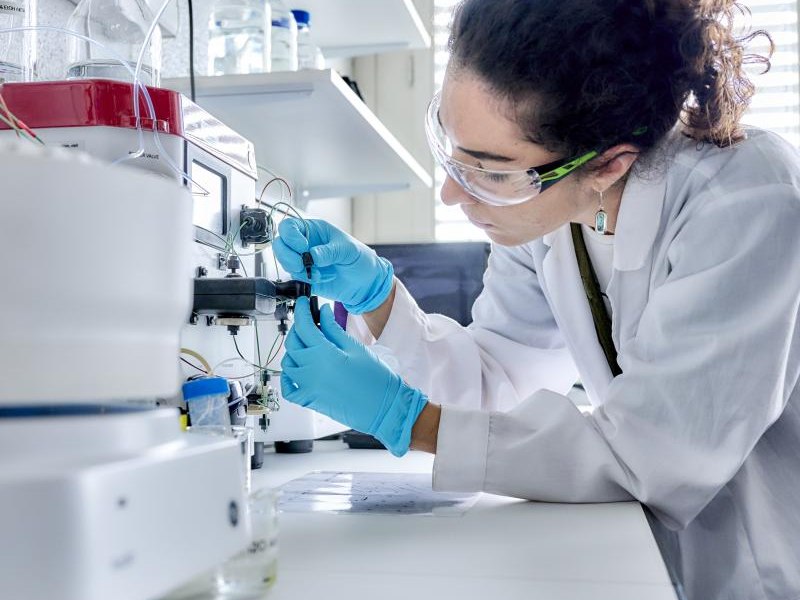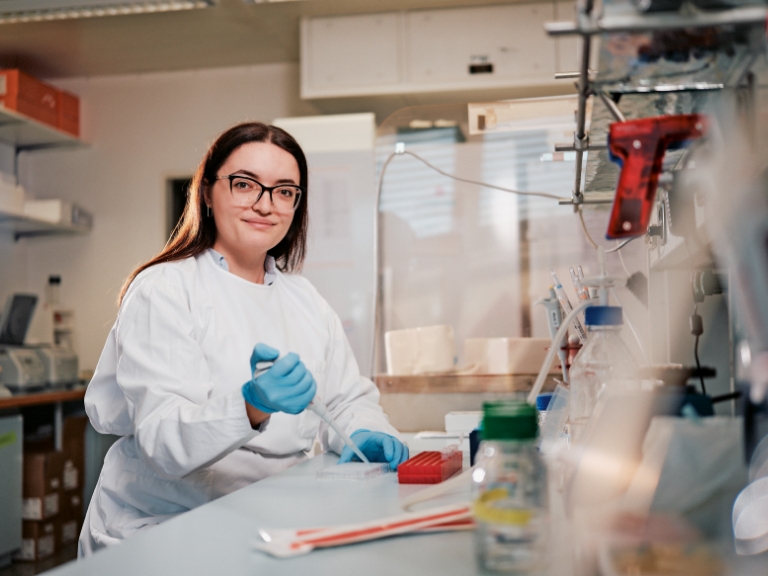20 years GCB
Promoting young researchers in biomedicine
Two research projects at the Graduate School for Cellular and Biomedical Sciences (GCB) demonstrate how scientific curiosity, clinical relevance, and social benefit can converge, providing a successful foundation for research careers.

The Graduate School for Cellular and Biomedical Sciences (GCB) was founded twenty years ago, making it the oldest of the University of Bern's eight graduate schools. These schools offer academic courses leading to a doctorate. “The GCB focuses on research in the cellular and biomedical sciences, such as biochemistry, immunology, and neurobiology,” explains its coordinator, Monica Schaller. “A key strength of our Graduate School is the close connection between the natural sciences, human medicine and veterinary medicine, as well as the robust support system we offer.”
Equally integral to the GCB is its international orientation, which provides students with a global perspective on scientific research. The school also offers an extensive range of scientifically oriented courses for doctoral students, designed not only to build technical expertise but also to develop a wide array of transferable skills. These include practical courses like scientific writing, which prepare graduates for diverse career paths in academia, industry, and beyond.
International cooperation
The GCB has grown and increased in diversity continuously since it was founded: while there were only 45 doctoral students in 2006, there are now 549 (from over 40 countries). “This development is largely driven by the fact that our doctoral program is highly attractive for international collaborations, fostering a dynamic exchange of knowledge and broadening research opportunities,” says Schaller.
The doctoral students come from a wide range of disciplines. “There are no clear trends as all areas are equally represented within the GCB, from basic biomedical research to clinical research,” Schaller says. She believes that the graduate school plays a key role in fostering young research talent: “Our program promotes a well-rounded scientific foundation paired with professional specialization. This is what makes our graduates highly competitive on the international stage.”
“Our program promotes comprehensive scientific expertise combined with professional specialization.”
Monica Schaller
Schaller is convinced that topics such as personalized medicine, biotechnology and artificial intelligence will become increasingly important in biomedicine over the next 20 years. “The GCB can serve as an interface between medical progress and health research by providing doctoral students with the best possible training for the challenges of the future.” In her view, it is important in research to incorporate as many perspectives as possible into a project. “Our prescribed supervision structure of three people aims to offer sufficient scientific support so that a doctoral thesis can be completed within three to four years.”
From aviation to biomedical engineering
Two current examples show how this can be achieved in practice: Karoline-Marie Bornemann and Lucilla Giammarino have each been awarded the GCB Best Thesis Award 2024. Bornemann, who obtained her Dipl.-Ing. in aerospace engineering at the University of Dresden in 2020, decided to switch from that discipline to biomedical engineering after listening to a lecture on biofluid dynamics.
She applied for a doctorate at the ARTORG Center for Biomedical Engineering Research. This research center is affiliated with the University of Bern and develops technologies for diagnosis, monitoring, therapy and rehabilitation in biomedicine.
“I've always been interested in fluid mechanics and turbulence,” she explains. “Interestingly, the aortic valve is the only place in the human body where blood flow can actually become turbulent.” This discovery led her to the subject of her doctoral thesis. In it, she investigated how and why the normally even blood flow at an artificial heart valve becomes turbulent, an effect which can then promote the formation of blood clots and thromboses.
Broad support, little competitive pressure
In addition to her main supervisor, Karoline-Marie Bornemann was supported by two other senior scientists “I submitted an annual progress report to the GCB to document how my project was progressing,” she says. Bornemann spent a total of four years at the University of Bern. “I loved my project. I particularly appreciated the supportive atmosphere - neither at the ARTORG nor at the GCB or in my research group was competition an issue.”
“I wanted to find out why and under what conditions blood flow can become turbulent.”
Karoline-Marie Bornemann
In 2020, the same year as Bornemann, Lucilla Giammarino also began her doctorate at the GCB. “My research focused on gender-specific differences in the electrical function of the upper chambers of the heart, i.e., the atria,” explains Giammarino. The aim was to better understand why these chambers of the heart are often affected by atrial fibrillation - a widespread cardiac arrhythmia. “We were able to show that the atria have certain characteristics that are different in women and men and influence susceptibility to atrial fibrillation.” This finding has also been confirmed by new studies.
“I wanted to contribute to the improvement of patient care - and thus to a social benefit.”
Lucilla Giammarino
“Scientific curiosity was an important driving force throughout my PhD,” she emphasizes. The clinical relevance of her research was also important to Lucilla Giammarino: “I wanted to contribute to improving patient care and thus achieve a social benefit.” And how does Giammarino look back on her three years at the GCB? “The multidisciplinary approach broadened my horizons - partly because I attended many courses outside my main field of research,” she summarizes.
Her supervisor and mentor also encouraged her to communicate her research findings in a way that is understandable to a wider audience. “Events like the annual GCB Symposium, which showcases doctoral students' research findings and offers a platform for discussion and networking, have also inspired us to think beyond our comfort zones.”
Winning the GCB Best Thesis Award 2024 is very important for both researchers. Karoline-Marie Bornemann speaks of “recognition for the work done and an incentive for new things”, while Lucilla Giammarino emphasizes: “The award further motivates me to continue doing meaningful research.”
And how does GCB Coordinator Monica Schaller comment on the award recipients´ respective success? “They absolutely deserve this award - not only because Both are very committed and want to make a difference with their research but also because of their attitudes.”
The Graduate School for Cellular and Biomedical Sciences (GCB)
The Graduate School for Cellular and Biomedical Sciences (GCB) is an interfaculty unit of the University of Bern. It organizes the PhD program in the fields of cell biology, biomedicine and related disciplines. The GCB is managed by an interfaculty committee and is designed to target graduates in the natural sciences, medicine, dentistry, veterinary medicine, pharmacy and, in some cases, engineering. The aim is to provide sound training in the theory and practice of experimental research.
About the person

Monica Schaller
completed her MSc in Molecular Biology and Ecology at the University of Fribourg and her PhD in the laboratory of Prof. Urs Nydegger at Bern University Hospital. She has been a habilitated immunohematologist at the Faculty of Medicine since 2015. She heads her own research group with a focus on autoimmune thrombotic diseases and is part of the “Blood Program” of the Department of Biomedical Research (DBMR) of the Hematology Department at Inselspital Bern. She has also coordinated the GCB since 2019.
About the person

Karoline-Marie Bornemann
studied aerospace engineering at the Technical University of Dresden and graduated in 2020 with a degree in engineering. For her doctorate, she moved to the ARTORG Center for Biomedical Engineering Research at the University of Bern, where she completed her doctorate under Prof. Dr. Dominik Obrist. She is currently a postdoctoral researcher at Stanford University. There she is researching the simulation of congenital valvular heart disease and surgical interventions in newborns.
About the person

Lucilla Giammarino
obtained her BSc in Biotechnology at the University of Bologna, where she also completed her MSc in Pharmaceutical Biotechnology in 2020. She wrote her doctoral thesis, supervised by Prof. Dr. med. Katja Odening, at Inselspital, Bern University Hospital and the University of Bern. Today she works as a postdoctoral fellow in Rochester (Minnesota), in a laboratory affiliated with the Mayo Clinic. There she researches genetic and molecular mechanisms that can be traced back to hereditary cardiac arrhythmias.
